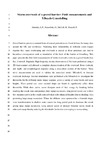Storm overwash of a gravel barrier: Field measurements and XBeach-G modelling
| dc.contributor.author | Almeida, LP | |
| dc.contributor.author | Masselink, G | |
| dc.contributor.author | McCall, R | |
| dc.contributor.author | Russell, P | |
| dc.date.accessioned | 2016-12-09T11:15:35Z | |
| dc.date.issued | 2017-02 | |
| dc.identifier.issn | 0378-3839 | |
| dc.identifier.issn | 1872-7379 | |
| dc.identifier.other | 0 | |
| dc.identifier.uri | http://hdl.handle.net/10026.1/8099 | |
| dc.description | publisher: Elsevier articletitle: Storm overwash of a gravel barrier: Field measurements and XBeach-G modelling journaltitle: Coastal Engineering articlelink: http://dx.doi.org/10.1016/j.coastaleng.2016.11.009 content_type: article copyright: © 2016 Elsevier B.V. All rights reserved. | |
| dc.description.abstract |
Gravel barriers provide a natural form of coastal protection and flood defence for many sites around the UK and worldwide. Predicting their vulnerability to different storm impact regimes that cause overtopping and overwash is crucial as these processes can lead to hazardous consequences such as inundation of the back of the barrier or breaching. This paper presents the first field measurements of storm overwash events on a gravel beach (Loe Bar, Cornwall, England). High frequency in-situ observations (2 Hz) were performed using a 2D laser-scanner and allowed a complete characterization of the overwash flows (velocity and depth) and morphological response along a cross-shore section of the barrier. These novel measurements are used to validate the numerical model XBeach-G, to forecast overwash discharge. Several simulations were performed with XBeach-G to investigate the thresholds for the different storm impact regimes, given a variety of water levels and wave heights. Wave period and wave spectral shape are found to significantly affect these thresholds. While short period waves dissipate most of their energy by breaking before reaching the swash zone and produce short runup excursions, long period waves due to their low steepness arrive at the swash zone unbroken with enhanced heights (due to shoaling) thus promoting large runup excursions. When the offshore wave spectrum has a bimodal shape, wave transformation in shallow water causes the long period peak to dominate the swash giving large runup excursions. Long period waves or strongly bimodal waves result in enhanced runup thereby reducing the thresholds for barrier overtopping or overwashing. | |
| dc.format.extent | 22-35 | |
| dc.language | en | |
| dc.language.iso | en | |
| dc.publisher | Elsevier BV | |
| dc.subject | Overwash | |
| dc.subject | Overtopping | |
| dc.subject | Remote sensing | |
| dc.subject | Gravel barrier | |
| dc.title | Storm overwash of a gravel barrier: Field measurements and XBeach-G modelling | |
| dc.type | journal-article | |
| dc.type | Article | |
| plymouth.author-url | https://www.webofscience.com/api/gateway?GWVersion=2&SrcApp=PARTNER_APP&SrcAuth=LinksAMR&KeyUT=WOS:000392773900002&DestLinkType=FullRecord&DestApp=ALL_WOS&UsrCustomerID=11bb513d99f797142bcfeffcc58ea008 | |
| plymouth.volume | 120 | |
| plymouth.publication-status | Accepted | |
| plymouth.journal | Coastal Engineering | |
| dc.identifier.doi | 10.1016/j.coastaleng.2016.11.009 | |
| plymouth.organisational-group | /Plymouth | |
| plymouth.organisational-group | /Plymouth/Admin Group - REF | |
| plymouth.organisational-group | /Plymouth/Admin Group - REF/REF Admin Group - FoSE | |
| plymouth.organisational-group | /Plymouth/Faculty of Science and Engineering | |
| plymouth.organisational-group | /Plymouth/Faculty of Science and Engineering/School of Biological and Marine Sciences | |
| plymouth.organisational-group | /Plymouth/REF 2021 Researchers by UoA | |
| plymouth.organisational-group | /Plymouth/REF 2021 Researchers by UoA/UoA07 Earth Systems and Environmental Sciences | |
| plymouth.organisational-group | /Plymouth/Research Groups | |
| plymouth.organisational-group | /Plymouth/Research Groups/Marine Institute | |
| plymouth.organisational-group | /Plymouth/Users by role | |
| plymouth.organisational-group | /Plymouth/Users by role/Academics | |
| plymouth.organisational-group | /Plymouth/Users by role/Researchers in ResearchFish submission | |
| dcterms.dateAccepted | 2016-11-08 | |
| dc.rights.embargodate | 2017-11-24 | |
| dc.identifier.eissn | 1872-7379 | |
| dc.rights.embargoperiod | Not known | |
| rioxxterms.funder | Engineering and Physical Sciences Research Council | |
| rioxxterms.identifier.project | Adaptation and Resilience of Coastal Energy Supply | |
| rioxxterms.versionofrecord | 10.1016/j.coastaleng.2016.11.009 | |
| rioxxterms.licenseref.uri | http://www.rioxx.net/licenses/all-rights-reserved | |
| rioxxterms.licenseref.startdate | 2017-02 | |
| rioxxterms.type | Journal Article/Review | |
| plymouth.funder | Adaptation and Resilience of Coastal Energy Supply::Engineering and Physical Sciences Research Council | |
| plymouth.funder | Adaptation and Resilience of Coastal Energy Supply::Engineering and Physical Sciences Research Council |


